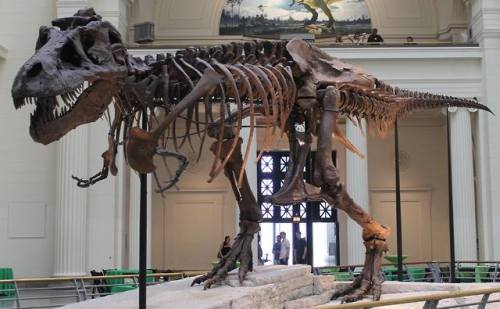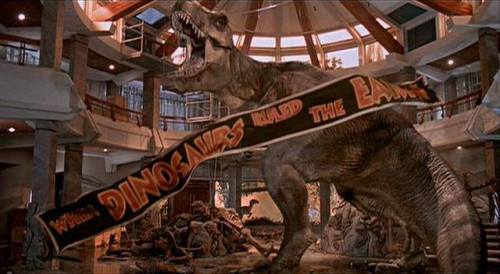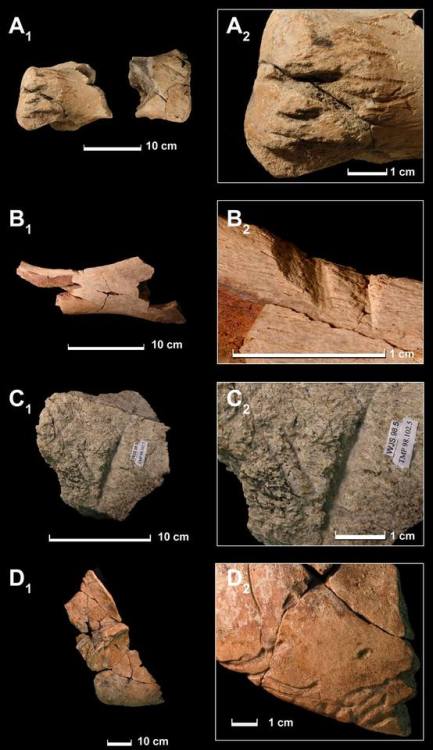Tyrannosaurus RexCommon name: Tyrannosaurus Rex (tye-RAN-uh-SAWR-us)Size: 12m (40 feet) in lengthAge
Tyrannosaurus RexCommon name: Tyrannosaurus Rex (tye-RAN-uh-SAWR-us)Size: 12m (40 feet) in lengthAge: Late Cretaceous (67 - 65 million years ago)Geographic range: North AmericaLiked: Eating other dinosaursDisliked: tiny arm jokesTaxonomy: Animalia > Chordata > Dinosauria > Theropoda > Tyrannosauridae > Tyrannosaurus > Tyrannosaurus RexNote: other species of Tyrannosaurus have been found in AsiaOne of the largest carnivorous land animals, Tyrannosaurus Rex (T-Rex for short) is also the most famous. T-Rex has been featured in more movies than any other dinosaur. Featured in all five of the Jurassic Park movies, T-Rex is one of the ultimate predators.Fossils show us that T-Rex had a huge skull with powerful jaws, packed with 7-inch serrated teeth. There’s been some debate as to whether or not T-Rex was a hunter or a scavenger based on the fossilized teeth. The theropod’s teeth were constantly being replaced over its lifetime and more recent studies have indicated T-Rex is an opportunistic predator that both hunted and scavenged.T-Rex was equipped with massive legs, enabling the dinosaur to run at speeds of up to 30 mph (48 km/hr). Adult dinosaurs measured 40 feet in length and weighed up to 10 tons. In contrast to its massive body, as any internet meme will tell you, T-Rex had relatively short, small arms. Although they seem vestigial and useless, the short forearms actually measured over three feet in length and may have been powerful enough to lift over 450 pounds (270 kg) each. This means T-Rex’s “tiny arms” were three times as powerful as a human’s.So what were these supposed “tiny arms” used for? Well, there are a few possibilities:1. A way to push themselves up off the ground.2. Male dinosaurs could have used them to hold onto females during mating3. To grab and hold onto prey before eating.So, most likely T-Rex’s arms were just the size they needed to be.In the first film of the series, Jurassic Park, we are told that T-Rex’s vision is based on movement and if we encounter one, all we have to do is remain still and it can’t see us. Sorry folks, but this is not the case. Based on fossils, we can see that the T-Rex skull has two large forward-facing eye sockets indicating the theropod had good binocular vision.A study conducted by Lawrence Witmer and Ryan Ridgely of Ohio University expanded on the already known sensory abilities of Tyrannosaurus, indicating relatively rapid and coordinated eye and head movements, an enhanced sense of smell, and an enhanced ability to sense low frequency sounds that would allow the dinosaur to track prey movements from long distances.Another study, published by Kent Stevens of the University of Oregon, concluded that Tyrannosaurus had excellent vision, with a binocular range of 55 degrees. What does that mean? Well it means T-Rex had better visual acuity than hawks and other predatory birds, and even better than humans.The most complete dinosaur skeleton ever discovered is a T-Rex skeleton. It was dug up in the Black Hills of South Dakota in 1990. FMNH PR 2081, or “Sue” is the the largest, most extensive and well-preserved T-Rex specimen ever discovered. Named for Sue Hendrickson (the discoverer), Sue measures 40 feet (12.3 m) long, stands 13 ft (4-m) tall at the hips, and weighs in at 6.4 metric tons. Despite being named Sue, the sex of the dinosaur is not known; however, we do know Sue was approximately 28 years old when he/she died. Sue resides in Chicago’s Field Museum, but occasionally is loaned out to other museums. The skeleton is 90 percent complete and contains one of only two complete T-Rex forelimbs in existence. The dinosaur also runs an impressive twitter account.-ALTImage Credit:Image #1 - Sue the T-Rex on display in Chicago (wikicommons)Image #2 - Universal Pictures/Jurassic ParkImage #3 - Dinosaur bones with T-Rex bite marks (wikicommons)Source Credit:http://bit.ly/ReXANshttp://bit.ly/1FXFlmwhttp://bit.ly/1JA8gfahttp://bit.ly/1E0KWm5http://bit.ly/1GXL73v -- source link
Tumblr Blog : the-earth-story.com
#dinosaur#fossil#fossils#tyrannosaur rex#fossilfriday#geology#paleontology#museum#research#jurassic park


